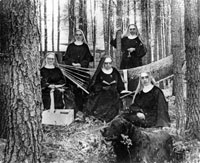
They’ve run schools, orphanages and hospitals since the nation’s earliest days. They've participated in civil rights marches and dialogued with government leaders both at home and abroad. Yet, the story of America’s Roman Catholic nuns and sisters remains largely untold.
Now a first-of-its kind exhibit at the California Museum in Sacramento aims to change that. "Women and Spirit: Catholic Sisters in America" features photographs, historical documents and artwork, and -- of course -- a variety of habits and wimples. The exhibit is now on its final stop of a three-year national tour that originated in Cincinnati and included time at the Smithsonian and Ellis Island. Through historic artifacts and numerous multimedia displays, visitors get an inside glimpse into the world of women who have spent the past 300 years shaping America’s social and cultural landscape.
Sister Katherine Doyle, a Sacramento-based historian and archivist with the order Sisters of Mercy, guided me through the main exhibit, as well as a smaller set of displays devoted to the history of California sisters, which are different than nuns, as Doyle explained.
Though the terms are often used interchangeably, Doyle said they actually describe two different categories of religious women. “Nuns are religious women who are enclosed,” she said. “All the work that they do is within their monastery or convent. So they might have schools or social services, but they have people come to them.”
Sisters, like Doyle herself, always work "out in the midst,” she said. So much so that people initially referred to her community, the Sisters of Mercy, as "walking nuns." Today, when you see Catholic religious women working places like social service offices and migrant camps and shelters, they are usually sisters, Doyle said.